It’s official.
I have just picked up India Yankee, the 1943 L4 Cub.

The aircraft was at Church Fenton/ Leeds East, and a bit of logistical planning was required. Brenda was bribed with the promise of a night in a hotel and the use of the car the next day to visit daughter Ellie and newborn Arthur, so I now had a lift down and the added bonus of space for any extras to come back.
After the formalities and with a full main tank and a full auxiliary tank it was time to set off northwards. I had planned a fuel stop at the halfway point – the delightful Northumbrian airfield of Eshott. It is a sign of the aircraft’s slow speed and the headwind on the day that Brenda was able to drive to Eshott and be there to meet me on landing. With snacks.
The route was north from Church Fenton, passing east of York and over the North York Moors to the coast at Redcar, then following the coast all the way past Hartlepool, Sunderland, South Shields, North Shields and Blyth before turning inland for Eshott.

The high wing and copious amounts of clear perspex make for good views, especially as I kept the height down as much as possible to get out of the teeth of the wind:

Cruising speed was 80mph, which is about 70 knots, and with a 30 knot headwind at times the groundspeed was down to 40. I could feel myself going grey. At one point passing Teeside I was convinced I was getting overtaken by an oil tanker on its way up the coast…

The wire fuel gauge seemed to go down really quickly, and I was thinking I would have to divert to Fishburn for fuel if I couldn’t transfer the auxiliary fuel from the wing tank into the main. Happily on opening the fuel valve the level in the wing went down and the wire in the main started to rise again until it was almost full. Loads of fuel! Panic over.
Eshott was windy, but straight down the runway so the landing was acceptable. I taxied up to the fuel truck and shut down one hour and fifty minutes after leaving Church Fenton. The airfield was quiet and it took some time to find a refueller but eventually the “almost empty” tanks took a grand total of 42 litres. Both tanks full is just under 80 so I had almost half the fuel left!

We took off again, the Cub and I, from Eshott and set course northwest. Now we were straight into wind and it took ages for the shadow to cross each field:

Eventually the coast of East Lothian crawled into view and we set off across the Firth of Forth towards Fife. Height by now was a little higher to give more options in the event of a problem. The auxiliary fuel transferred as advertised once again and endurance was no longer a concern.

Passing a rig off Kirkcaldy the wind shadow gives an idea of the strength of the wind:

Finally back over dry land at Leven. Onto the home stretch now…

Crossing the flat part in the middle of Fife near Ladybank:

And finally into the traffic pattern at Perth, an OK landing and taxied up to shut down at the work hangar, causing a bit of excitement:

Home at last…

After almost four hours of flying I wasn’t in the mood to wrestle the aircraft into its new spot in the aero club hangar, so we put it at the back of the work hangar. Total and utter coincidence that the “CUB” lettering is the right way up:

Next day I moved the aircraft into its new home, but not without going for a wee flight first:

Proving once again that it is a great little spotter plane. Awesome views from low level:

And finally into the new hangar spot. Eindecker and Cub back-to-back:

Sigurd Martin now stands for “Speed Machine” if it’s the RV6, or “Slow Machine” if it’s the Eindecker or Cub.
A couple of days later at work I rediscovered the excellent Mountain Weather Information Service website at http://www.mwis.org.uk – their simplified chart for the day of the ferry flight looked like this:

If I had seen the word “gale” before setting off I probably would have left the aircraft in the hangar!
